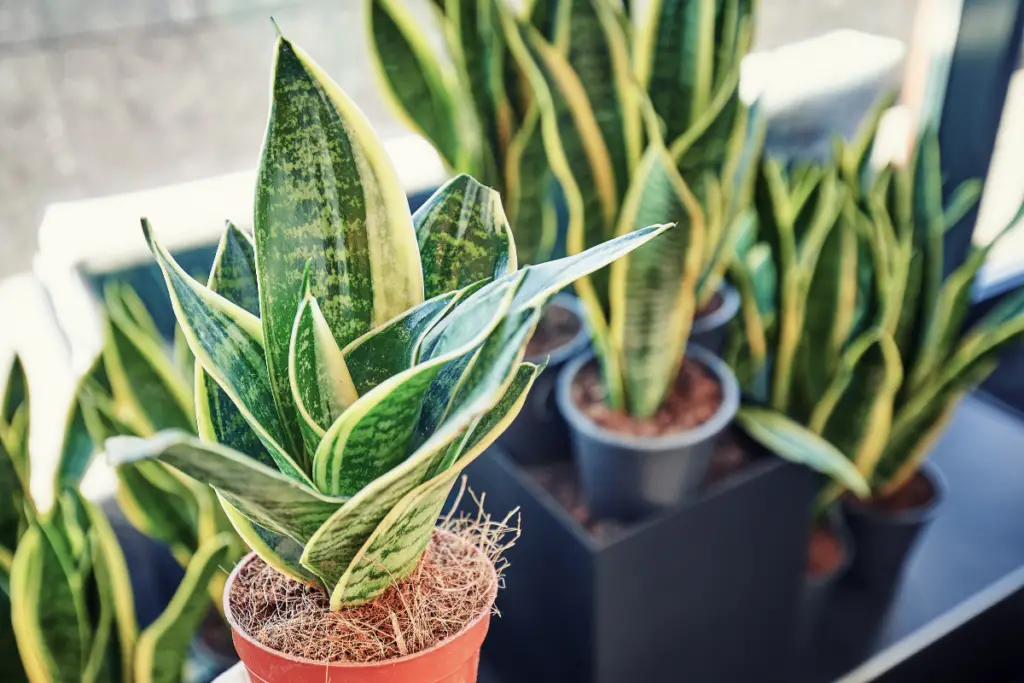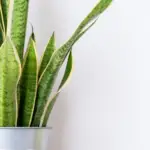Dracaena Trifasciata, also known as the snake plant, is a popular ornamental houseplant that belongs to the family Asparagaceae.
Native to tropical West Africa, this plant is known for its long, sword-like leaves that are variegated with shades of green and yellow.
The snake plant is extremely easy to grow at home and requires little care, making it a favorite among novice and experienced gardeners alike.
One of the most remarkable features of the snake plant is its hardiness. In fact, this plant almost thrives on neglect, making it an ideal choice for those who don’t have a lot of time or energy to devote to plant care.
It can tolerate low light conditions, infrequent watering, and a wide range of temperatures, making it a versatile addition to any home or office.
Additionally, the snake plant is known for its air-purifying properties, making it a popular choice for those who want to improve the air quality in their homes.

Table of Contents
What Is Dracaena Trifasciata?
Dracaena trifasciata, also known as the snake plant, is a species of flowering plant in the family Asparagaceae.
It is native to tropical West Africa, specifically from Nigeria to the Congo. The plant is most commonly known as the snake plant, Saint George’s sword, mother-in-law’s tongue, and viper’s bowstring hemp, among other names.
The snake plant is an evergreen, perennial tropical plant that grows in sunny and warm locations. It has stiff, vertical leaves that give the plant its unique appearance.
The leaves grow from the base of the plant and can grow up to 4 feet long and 2-3 inches wide.
The leaves are dark green with light gray-green cross-banding and can have a yellow or cream border.
One of the most distinctive features of the snake plant is its ability to thrive in low light conditions. It can tolerate very low light and still grow well, making it an ideal plant for indoor spaces.
The snake plant is also known for its air-purifying properties, which makes it a popular choice for bedrooms and living areas.
In recent years, there has been a change in the scientific classification of the snake plant. The genus name for snake plants has been reclassified from Sansevieria Trifasciata to Dracaena Trifasciata.
The name change took effect in 2017/18 due to observed similar characteristics between the Dracaena genus and snake plants. However, some gardeners still refer to the plant as Sansevieria Trifasciata.
Origin and Habitat of Dracaena Trifasciata
Dracaena Trifasciata, commonly known as the snake plant, is a species of flowering plant in the family Asparagaceae.
It is native to tropical West Africa, from Nigeria east to the Congo. The plant has been naturalized in many tropical and subtropical regions around the world and is cultivated as an ornamental plant.
The snake plant grows in a variety of habitats, including forests, grasslands, and rocky outcrops. It is a hardy plant that can tolerate a wide range of growing conditions, making it a popular choice for indoor gardening.
In its natural habitat, the snake plant is often found growing in the understory of forests. It is a slow-growing plant that can take several years to reach its full size.
The leaves of the snake plant are long and sword-shaped, growing up to 4 feet tall in some cases.
The snake plant is known for its ability to purify the air by removing toxins such as benzene, formaldehyde, and trichloroethylene.
This makes it a popular choice for indoor environments, including homes and offices.
Overall, the snake plant is a hardy and adaptable plant that can thrive in a variety of growing conditions.
Its natural habitat in West Africa provides a clue to its growing requirements, which include well-drained soil and partial sun exposure.
Physical Characteristics
Dracaena trifasciata, commonly known as the snake plant, is a species of flowering plant in the family Asparagaceae. It is native to tropical West Africa, from Nigeria to the Congo.
The plant has a distinctive appearance, with long, sword-shaped leaves that grow upright from a central rosette.
The leaves of the snake plant are typically green with yellow or white stripes or variegation.
The plant can grow up to 4 feet tall, and its leaves can reach up to 2 feet in length, depending on the variety. The leaves are thick and fleshy, and they grow in a tight, upright formation.
The snake plant is an evergreen perennial, meaning that it retains its leaves year-round.
The plant also produces small, fragrant flowers on a long stem, which emerge from the center of the rosette. However, the flowers are not particularly showy, and the plant is primarily grown for its foliage.
In terms of care, the snake plant is a relatively low-maintenance plant. It is drought-tolerant and can thrive in a range of lighting conditions, from bright, direct light to low, indirect light.
The plant prefers well-draining soil and does not require frequent watering. Overwatering can cause the plant to rot, so it is important to allow the soil to dry out between waterings.
Overall, the snake plant’s physical characteristics make it a popular choice for indoor and outdoor gardens alike.
Its striking appearance and ease of care make it an ideal plant for beginners and experienced gardeners alike.
Growth and Development
Dracaena Trifasciata is a slow-growing plant that can reach up to 2-4 feet in height and 1-2 feet in width. It has long, sword-shaped leaves that are dark green with light green or yellow stripes.
The leaves grow up to 2-3 feet in length and 2-3 inches in width. The plant grows in an upright manner, and the leaves grow directly from the stem.
This plant is native to West Africa, where it grows in tropical forests. It is an adaptable plant that can grow in a variety of conditions.
It can tolerate low light conditions, making it an ideal plant for indoor settings. It is also drought-tolerant and can survive long periods without water.
Dracaena Trifasciata is a low-maintenance plant that requires minimal care. It grows best in loose, well-draining soil, and should be watered only when the soil dries out.
Overwatering can cause the roots to rot, so it is important to ensure that the soil is not too wet.
The plant can be propagated by stem cuttings, which can be rooted in water or soil. The cuttings should be taken from healthy plants and should be at least 4-6 inches long.
The cuttings should be allowed to dry for a few hours before being planted in soil. The new plants should be kept in a warm, humid environment until they are established.
Overall, Dracaena Trifasciata is a hardy plant that is easy to care for and can add a touch of greenery to any indoor space.
With proper care, this plant can live for many years and continue to grow and thrive.
Caring for Dracaena Trifasciata
Dracaena Trifasciata, commonly known as the snake plant, is a popular houseplant that is easy to care for and can thrive in a variety of environments. Here are some tips for caring for your Dracaena Trifasciata:
Lighting Requirements
Dracaena Trifasciata requires bright, filtered sunlight to grow properly. It can also tolerate partial shade, but direct sunlight can scorch its leaves.
Placing the plant near a window that faces east or west is ideal. If the plant is placed in a darker area, it may not grow as quickly, but it will still survive.
Watering Requirements
Dracaena Trifasciata is a drought-tolerant plant that does not require frequent watering. Overwatering can lead to root rot, so it is important to let the soil dry out between waterings.
Water the plant once a month from below when the top 2 inches of soil is dry (5 cm). It is important to avoid getting water on the leaves, as this can cause them to rot.
Soil and Fertilizer Requirements
Dracaena Trifasciata grows best in loose, well-draining soil. A mix of potting soil, sand, and perlite is ideal.
The plant should be fertilized once a month during the growing season with a balanced liquid fertilizer of NPK 10-10-10 at half-strength.
It is important not to over-fertilize the plant, as this can cause the leaves to become yellow and wilted.
By following these simple care instructions, your Dracaena Trifasciata will thrive and add a touch of green to your home or office.
Also check out our full article: Best Fertilizer for Snake Plant
Common Problems and Solutions
Dracaena Trifasciata is a popular houseplant that is known for its striking foliage and ease of care. However, like any plant, it can experience problems that can affect its growth and health.
Here are some common issues that can arise with Dracaena Trifasciata and how to solve them.
Pest Infestations
Dracaena Trifasciata can be susceptible to certain pests such as spider mites, mealybugs, and scale insects.
These pests can cause damage to the leaves and stem of the plant, leading to discoloration and stunted growth.
To combat these pests, it is important to regularly inspect the plant for signs of infestation and to take immediate action if any are found.
One effective way to control pests is to wipe down the leaves and stem of the plant with a damp cloth.
This can help to remove any pests that are present and prevent them from spreading. In severe cases, it may be necessary to use an insecticidal soap or pesticide to eliminate the pests.
Disease Issues
Dracaena Trifasciata can also be prone to certain diseases such as leaf spot, root rot, and fungal infections.
These diseases can cause the leaves to turn yellow or brown, and can eventually lead to the death of the plant.
To prevent these diseases from occurring, it is important to maintain proper watering and drainage practices.
Overwatering is a common cause of root rot and fungal infections, so it is important to only water the plant when the soil is dry to the touch.
In addition, it is important to ensure that the plant is not sitting in standing water, as this can lead to root rot.
If disease is suspected, it is important to remove any affected leaves and treat the plant with a fungicide.
Environmental Concerns
Dracaena Trifasciata can also experience problems due to environmental factors such as temperature, humidity, and lighting.
For example, if the plant is exposed to temperatures that are too cold or too hot, it can cause the leaves to wilt or turn yellow.
Similarly, if the plant is exposed to low humidity, it can cause the leaves to dry out and become brittle.
To prevent these issues, it is important to provide the plant with the proper environmental conditions.
This includes keeping the plant in a room with a temperature between 60-80°F, maintaining a humidity level of 40-50%, and ensuring that the plant is not exposed to direct sunlight.
If the plant is not receiving enough light, it may be necessary to move it to a brighter location or to supplement with artificial light.
Propagation Methods
Dracaena Trifasciata is a popular houseplant that can be propagated in several ways. Here are some of the most common methods:
Stem Cuttings
Stem cuttings are a popular way to propagate Dracaena Trifasciata. To do this, cut a stem from the mother plant that is at least 4 inches long and contains several leaves.
Remove the lower leaves from the cutting and dip the cut end in rooting hormone. Plant the cutting in a pot filled with well-draining soil and keep it moist.
Place the pot in a bright, indirect light, and wait for the cutting to root. This process usually takes around 4-6 weeks.
Leaf Cuttings
Leaf cuttings are a less common way to propagate Dracaena Trifasciata. To do this, cut a leaf from the mother plant and divide it into several sections.
Plant each section in a pot filled with well-draining soil and keep it moist. Place the pot in a bright, indirect light, and wait for the cuttings to root. This process usually takes around 4-6 weeks.
Division
Division is a simple way to propagate Dracaena Trifasciata. To do this, remove the plant from its pot and gently separate the rhizomes.
Plant each rhizome in a pot filled with well-draining soil and keep it moist. Place the pots in a bright, indirect light, and wait for the plants to grow. This process usually takes around 4-6 weeks.
Propagation is a great way to create new plants and expand your collection of Dracaena Trifasciata.
By using any of these methods, you can create new plants that are genetically identical to the mother plant.
Benefits and Uses
Dracaena Trifasciata, commonly known as Snake Plant, is a popular houseplant that not only adds to the aesthetic appeal of a room but also offers numerous benefits.
Here are some of the benefits and uses of Dracaena Trifasciata:
Air Purification
Dracaena Trifasciata is known for its ability to purify the air by removing toxins such as formaldehyde, benzene, and xylene.
According to a study conducted by NASA, Snake Plant is one of the top air-purifying plants that can help improve indoor air quality.
Health Benefits
Apart from air purification, Snake Plant also offers various health benefits. It is believed that the plant can help in reducing stress, anxiety, and fatigue.
According to a study by the University of Agriculture, Faisalabad, Pakistan, Snake Plant has a positive impact on human physiology and can help in reducing stress levels.
Decorative Purposes
Dracaena Trifasciata is a beautiful plant that can add to the aesthetic appeal of a room. It has long, sword-like leaves that come in various shades of green and yellow.
The plant is easy to care for and can thrive in a variety of conditions, making it a popular choice for indoor decoration.
Feng Shui
In Feng Shui, Snake Plant is believed to bring good luck and positive energy into a room.
It is considered to be a symbol of strength and resilience and is often placed in the entrance of a house or office to ward off negative energy.
Overall, Dracaena Trifasciata is a versatile plant that offers numerous benefits and uses.
Whether you want to improve indoor air quality, reduce stress levels, or add to the aesthetic appeal of your room, Snake Plant is an excellent choice.
Conclusion
Dracaena trifasciata is a popular houseplant due to its attractive appearance and low maintenance requirements.
It is commonly known as the snake plant, Saint George’s sword, mother-in-law’s tongue, and viper’s bowstring hemp, among other names.
This plant is native to tropical West Africa from Nigeria east to the Congo and is a species of flowering plant in the family Asparagaceae.
Dracaena trifasciata is an evergreen ornamental houseplant with long sword-like variegated green and yellow leaves. It is an erect, clumping, broadleaf evergreen houseplant that can grow up to 4 feet tall.
The plant is extremely easy to grow at home and requires little care. In fact, the snake plant is so hardy that it almost thrives on neglect.
One of the most beneficial aspects of Dracaena trifasciata is its air-purifying properties. It has been found to remove toxins such as formaldehyde, benzene, and trichloroethylene from the air.
This makes it an ideal plant for offices, homes, and other indoor spaces.
Overall, Dracaena trifasciata is an attractive and easy-to-care-for houseplant with air-purifying properties.
Its unique appearance and low maintenance requirements make it a popular choice for plant enthusiasts of all levels.
- How to Dry Basil Leaves: A Professional Guide
- Is an Avocado a Fruit or Vegetable? Simple Answer and Explanation
- Does Pineapple Have Seeds? Exploring the Anatomy of Pineapples
- Blooming Through Winter: Can I Grow Vegetables Indoors in the Winter?
- What Can You Grow in a Greenhouse All Year Round: A Guide to Year-Round Greenhouse Gardening
- Are Blueberries Blue? Debunking the Myth of Their Color
















